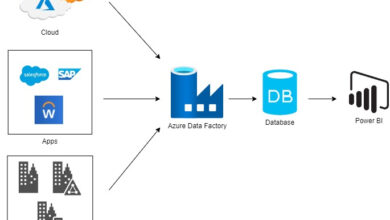Unleash Azure CLI: Expert Cloud Control
Introduction
In the dynamic world of cloud computing, effectively managing and controlling resources and services is of utmost importance. Enter Azure Command-Line Interface (CLI), a powerful tool that empowers developers, administrators, and DevOps teams to seamlessly interact with and manage Azure resources. Azure CLI provides a command-line interface that simplifies tasks like resource provisioning, deployment, monitoring, and management. This article dives deep into the capabilities and advantages of Azure CLI, shedding light on its practical applications.
The Power of Azure CLI
Azure CLI is an open-source, cross-platform command-line tool that makes managing Azure resources a breeze. It ensures a consistent experience across different platforms, allowing users to interact with Azure services regardless of their operating system. With Azure CLI, users can perform various tasks such as creating and managing virtual machines, configuring networks, handling storage, deploying web apps, and more.
Key Features and Benefits
- Cross-Platform Compatibility: Azure CLI stands out with its ability to run on Windows, macOS, and Linux systems. This enables users to manage their Azure resources from their preferred environment without any platform restrictions.
- Scripting and Automation: Azure CLI facilitates automation through scripting. Users can write scripts to define and deploy resources, allowing for streamlined and repeatable processes. This is particularly valuable in DevOps scenarios where rapid deployment and configuration changes are critical.
- Intuitive Syntax: Azure CLI utilizes a straightforward and consistent syntax for all commands. This reduces the learning curve for users who are already familiar with other command-line tools. The commands are designed to be self-explanatory, making them accessible even to beginners.
- Comprehensive Documentation: Microsoft provides extensive documentation for Azure CLI, including a detailed command reference, usage examples, and best practices. This documentation serves as a valuable resource for both newcomers and experienced users.
- Integration with Azure Services: Azure CLI seamlessly integrates with various Azure services, allowing users to manage a wide range of resources. Whether it’s creating virtual networks, managing databases, or configuring security policies, Azure CLI offers a unified interface.
Practical Applications
- Resource Provisioning: Azure CLI enables quick creation of resources. By writing scripts that define the desired configuration, users can effortlessly deploy resources like virtual machines, databases, and storage accounts.
- Deployment Automation: In a continuous integration and continuous deployment (CI/CD) pipeline, Azure CLI can be integrated to automate the deployment of applications and services. This ensures consistent and reliable deployments.
- Scaling Resources: With Azure CLI, users can dynamically scale their resources up or down as needed. This is crucial for handling varying workloads and optimizing resource utilization.
- Monitoring and Management: Azure CLI allows users to monitor the health and performance of their resources. By retrieving metrics and logs, administrators can gain insights into their applications’ behavior and take proactive measures.
- Security Configuration: Configuring security settings and access controls is made easier with Azure CLI. Users can define security rules, manage authentication, and implement encryption using command-line instructions.
Popular Azure CLI Commands
Azure CLI offers a rich set of commands that enable users to interact with and manage various Azure services. Here are some popular commands that demonstrate the versatility and utility of Azure CLI:
Login to Azure
az login
This command initiates the login process, allowing users to authenticate and access their Azure subscription. After successful authentication, users can begin managing their resources.
List Subscriptions
az account list --output table
This command lists all the Azure subscriptions associated with the logged-in account. It provides useful information such as subscription name, subscription ID, and the currently selected subscription.
Create a Virtual Machine
az vm create --resource-group myResourceGroup --name myVM --image UbuntuLTS --admin-username azureuser --admin-password Azure12345678
This command creates a virtual machine in the specified resource group with the provided parameters. Users can customize the image, VM name, and authentication credentials as needed.
Create a Storage Account
az storage account create --name mystorageaccount --resource-group myResourceGroup --location eastus --sku Standard_LRS
This command creates a storage account in the specified resource group, location, and SKU (Storage Account type). Storage accounts are essential for storing data objects such as blobs, files, and queues.
List Virtual Networks
az network vnet list --output table
This command retrieves a list of virtual networks within the current subscription. Virtual networks are fundamental for creating isolated network environments for resources like virtual machines.
Deploy Web App
az webapp up --sku F1 --name mywebapp
Deploy a web app with a free pricing tier. This command provisions the necessary resources and deploys the specified web application code to Azure.
List Resource Groups
az group list --output table
List all resource groups within the current subscription. Resource groups serve as containers for resources, allowing for improved organization and management.
Scale App Service Plan
az appservice plan update --name myplan --resource-group myResourceGroup --number-of-workers 3
Adjust the number of instances (workers) in an App Service Plan to handle increased traffic load. This is useful for optimizing resource allocation for web applications.
List Key Vault Secrets
az keyvault secret list --vault-name myvault --output table
Retrieve a list of secrets stored in an Azure Key Vault. Key Vault is used to securely manage sensitive information like passwords, certificates, and API keys.
List Cosmos DB Accounts
az cosmosdb list --output table
List all Cosmos DB accounts within the current subscription. Cosmos DB is a globally distributed database service that supports multiple data models.
Create an IoT Hub
az iot hub create --name myiothub --resource-group myresourcegroup --sku S1
This command creates an IoT Hub with the specified name, resource group, and SKU (S1 in this case).
List IoT Hubs
az iot hub list --output table
List all IoT Hubs within the current subscription.
Show IoT Hub Details
az iot hub show --name myiothub --resource-group myresourcegroup
Display detailed information about a specific IoT Hub.
Create an IoT Device
az iot device create --hub-name myiothub --device-id mydevice
Create an IoT device in the specified IoT Hub.
List IoT Devices
az iot device list --hub-name myiothub --output table
List all IoT devices in the specified IoT Hub.
Get IoT Device Details
az iot device show --hub-name myiothub --device-id mydevice
Display detailed information about a specific IoT device.
Send Device-to-Cloud Messages
az iot device c2d-message send --hub-name myiothub --device-id mydevice --data "Hello IoT"
Send a cloud-to-device message to a specific IoT device.
Monitor IoT Hub Events
az iot hub monitor-events --hub-name myiothub --device-id mydevice
Start monitoring events from a specific IoT device.
Create IoT Edge Device
az iot edge device create --hub-name myiothub --device-id myedgedevice --edge-enabled
Create an IoT Edge device in the specified IoT Hub.
List IoT Edge Devices
az iot edge device list --hub-name myiothub --output table
List all IoT Edge devices in the specified IoT Hub.
Invoke Direct Method on Device
az iot device invoke-method --hub-name myiothub --device-id mydevice --method-name mymethod --method-payload "{'param1': 'value1'}"
Invoke a direct method on a specific IoT device.
Create IoT Hub Consumer Group
az iot hub consumer-group create --hub-name myiothub --name mygroup
Create a consumer group in the specified IoT Hub.
These commands only provide a glimpse of what Azure CLI can do. By combining these commands with scripting and automation, users can efficiently manage complex cloud environments, deploy applications, and configure resources with precision.
Conclusion
In the ever-evolving landscape of cloud computing, Azure CLI emerges as a powerful tool for efficiently managing Azure resources. Its cross-platform compatibility, intuitive syntax, and integration with Azure services make it an invaluable asset for developers, administrators, and DevOps teams. By automating resource provisioning, deployment, monitoring, and management, Azure CLI empowers users to focus on innovation rather than mundane tasks. As cloud environments continue to evolve, mastering Azure CLI becomes an essential skill for thriving in the world of cloud computing.
Know more about our company at Skrots. Explore our wide range of services at Skrots Services. Also, check out our informative blogs at Blog at Skrots. Thank you for considering Skrots as your cloud computing partner.




